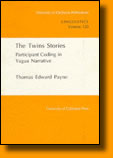The Twins Stories: Participant Coding in Yagua Narrative
(University of California Publications in Linguistics, Vol 120)
Thomas E. Payne

|
Yagua is an Amerindian language currently spoken by about 3,000 individuals in the north-western Amazon basin, primarily in Perú. This book has 2 goals: 1) to provide clear, and accurate descriptive data on one of the many relatively unstudied languages of the Amazon region, and 2) to test certain hypotheses concerning the functional factors that contribute to a speaker's choice of participant reference forms in discourse.
Chapters 2 and 3 constitute a purely descriptive study of the various participant coding devices available in Yagua. In chapter 4 a quantitative study of the use of participant coding devices in a body of folkloric texts is undertaken, and the results presented. This study confirms the general findings of much recent work on the use of anaphora in discourse, though certain problems are noted.
In chapter 5 individual deviations from the general findings of chapter 4 are discussed. It is found that there are 7 conditions under which recently-mentioned participants can be coded with 'larger' (i.e. more explicit) coding devices. Each of these conditions are discussed in detail, and functional explanations offered.
Chapter 6 investigates the discourse functions of morphosyntactically 'stative' intransitive verbs. A quantitative study reveals that 'stative' marking of intransitive verbs is dependent on the discourse-pragmatic notions of 'change in locational scene', 'unexpected action' and 'episodic climax', rather than on semantic stativity.
Chapter 7 deals with the discourse functions of free pronouns. In Yagua, free pronouns are used for more recently mentioned participants than is 'verb agreement', even though the former is phonologically larger than the latter. This fact seems to violate the 'iconicity principle of topic continuity' (Giv[on, 1983c). Closer examination of the textual data reveals that free pronouns are used in situations of 'selective contrast' and when the topicality of a participant has not yet been fully established. In other words, the functional domain of free pronouns is independent of that of verb agreement.
Chapter 8 summarizes the findings of the study and suggests directions for future research. One ammajor conclusion of the study is that the two indices of topic continuity termed 'Referential Distance' and 'Persistence' do not quantify the same functional domain, as is assumed in much previous work. It is suggested that the functional domains coded by these indices are 'topic continuity' and 'deployability' respectively.
